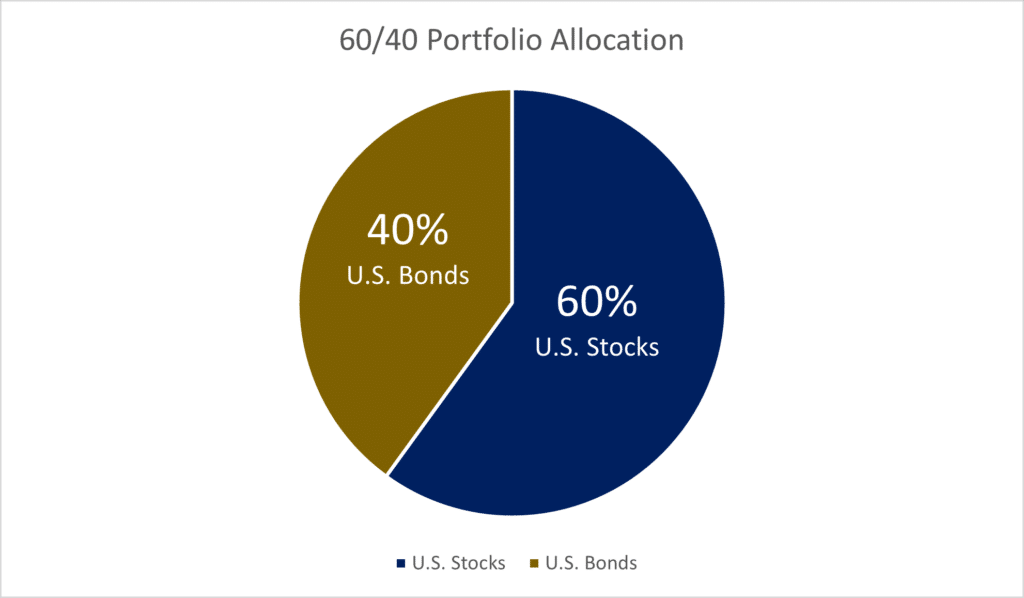
When the Federal Reserve (the Fed) raised interest rates in 2022 and 2023 to combat inflation, people started to question if the 60/40 portfolio was still a good investment allocation strategy. The “40” in “60/40” represents bond investments, and since the rise in interest rates was causing the value of bonds to drop, it started to seem that allocating 40% of your portfolio to bonds was a bad bet.
But the 60/40 portfolio, when implemented correctly, can provide stability in your portfolio, even during times of rising interest rates. In this article, I explain what you need to know about the 60/40 portfolio to make it work for you – its benefits, its drawbacks, and how it should be managed when interest rates are on the rise.
What is a 60/40 portfolio?
A “60/40” portfolio is a common portfolio allocation, typical for someone in or near retirement. If you have a 60/40 portfolio, 60% of your investments are allocated to stocks (or risk assets) and 40% is allocated to bonds, or secure income producing assets. The idea and math behind the 60/40 portfolio are that your portfolio is less subjected to risk while still being able to grow. The secure portion – the 40% – can also provide cash flow.

Origins of the 60/40 Portfolio
The genesis of the 60/40 portfolio can be found in Modern Portfolio Theory, which has for decades influenced how financial advisors and institutions invest. Developed in 1952 by Nobel prize-winning economist Harry Markowitz, Modern Portfolio Theory suggests that “investors can construct portfolios to maximize expected returns based on a given level of market risk.”
Originally favored by institutional investors and foundations with distribution requirements, the 60/40 allocation model was designed to provide consistent growth while meeting income obligations. But the advent of mutual funds and exchange-traded funds (ETFs) made the 60/40 portfolio more accessible to individual investors.
What are the benefits of the 60/40 portfolio?
What makes the 60/40 portfolio appealing, particularly to those at retirement age, is that it hedges against risk and volatility. Bonds are not regarded as a great way to enhance your wealth (stocks can give a much greater return on investment), but bonds are also less exposed to risk. If a recession hits, traditionally, the Fed will lower interest rates to boost the economy. Since the value of bonds often rises when interest rates fall, your bond portfolio will counterbalance the losses in your stock portfolio when a recession hits.
One of the driving forces behind the popularity of the 60/40 portfolio was the recognition of the significance of asset allocation. According to investment experts, approximately 80-90% of an investor’s overall returns are determined by their asset allocation decisions rather than specific individual investment choices. This realization underscored the importance of having a well-structured portfolio that combines diversification, growth potential and risk management.
Why did people start to doubt the 60/40 portfolio?
In 2020 and 2021, interest rates were at all-time lows, making bonds – especially long-term bonds – a much riskier investment. Interest rates only had one direction they could go – up – and when interest rates rise, bond values decrease.
Then in 2022 and 2023, the Fed started to raise interest rates to curb inflation, after telegraphing this move for the better part of 6 months. This caused the value of mid- and long-term bonds to fall at a much faster rate than short-term bonds. Suddenly, investors who had bought up long-term bonds when interest rates were low were seeing the value of their portfolio decrease significantly. The average midterm bond portfolio lost an estimated 15% between 2021 and 2022, which takes a long time to make up when the yields were close to 2% in 2020. This began the discussion and signaled to many that a 60/40 portfolio allocation – long regarded as the safe, conservative model of investing – was no longer a secure way to invest.
Does this mean the 60/40 portfolio is dead?
Even though (as of August 2023) interest rates are still on the rise, the 60/40 portfolio is not dead. In fact, the 60/40 portfolio can still be a risk-averse portfolio allocation, provided it’s implemented correctly.
How do you achieve a 60/40 portfolio that is risk-averse in an environment of high interest rates?
- Pay Attention to the Economy, History, and what the Fed is saying about interest rates
First and foremost, the essence of portfolio management is managing risk and you must pay attention to economic signals to manage risk. Leading into 2022, inflation peaked near 10% and the Fed was telegraphing that it was going to raise rates. This was a sign that your bond portfolio couldn’t be saddled with the risk of long-term bonds, but some investors and advisors either didn’t understand, or didn’t care.
- Offload long-term bonds and invest in high-quality, short-term bonds
Secondly, when the Fed is signaling a rise in interest rates, you need to offload long-term bonds and invest in high-quality, short-term bonds with a lower duration. Short-term bonds with a lower duration don’t lose as much value, and can even maintain value, when interest rates rise. This ensures that you can still have 40% of your portfolio marked as the “safe and stable” portion.
- Do not chase yield
Lastly, you need to understand that the 40% portion marked for bonds is TRULY supposed to be the stable portion, and not try to chase yield with it. When interest rates started to rise, many investors were investing in long-term bonds that were only getting .5% more than shorter-term bonds; when they did this, they introduced a great deal of risk into their portfolio.
Conclusion
The 60/40 portfolio remains a valuable investment strategy, offering a balance between growth and stability. However, its success relies on more than just a static allocation. Investors and advisors must adapt the strategy to the current economic environment, investor goals, and risk tolerance. By considering the lessons from history, recognizing the potential pitfalls, and strategically adjusting the portfolio’s components, investors can maximize the benefits of the 60/40 allocation strategy and work toward their long-term financial goals.
If you have questions about your portfolio allocation, your investment management, or your retirement planning, book a free consultation with Winthrop Partners.
Disclosures:
The views, opinions, and content presented are for informational purposes only. They are not intended to reflect a current or past recommendation; investment, legal, tax, or accounting advice of any kind; or a solicitation of an offer to buy or sell any securities or investment services. Nothing presented should be considered to be an offer to provide any product or service in any jurisdiction that would be unlawful under the securities laws of that jurisdiction. All investments involve risk, including the possible loss of some or all of the principal amount invested. Past performance of a security or financial product does not guarantee future results. Investors should consider their investment objectives, risks, and risk tolerances carefully before investing. The Firm has made every attempt to ensure the accuracy and reliability of the information provided, but it cannot be guaranteed.

Brian Werner is a Managing Partner at Winthrop Partners. He has more than 25 years of experience in investments, financial planning, entrepreneurial ventures, corporate finance, and banking. Prior to joining Winthrop Partners, Brian was the First Vice President and a Senior Wealth Advisor for First Niagara, where he led the development of First Niagara’s Western Pennsylvania Private Client Services and served on its western Pennsylvania operating committee. He also held roles with PNC/National City, Greycourt Investment Advisors, and Linnco Future Group, Chicago Board of Trade. Brian is a Chartered Financial Analyst and Certified Financial Planner. He earned his MBA from Duquesne University, Magna Cum Laude.

